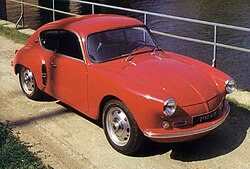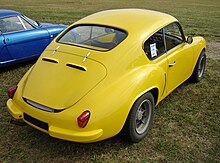Alpine A106
| Alpine | |
|---|---|
|
Alpine A106 Coach Mille Miles
|
|
| A106 | |
| Production period: | 1955-1963 |
| Class : | Sports car |
| Body versions : | Coupé , convertible |
| Engines: |
Otto engines : 0.75–0.9 liters (15–43 kW) |
| Length: | 3700 mm |
| Width: | 1450 mm |
| Height: | 1170-1270 mm |
| Wheelbase : | 2100 mm |
| Empty weight : | 530-555 kg |
| Previous model | Renault 4CV Rédélé Special |
| successor | Alpine A108 |
The Alpine A106 was a sports car designed by Jean Rédélé as a rally car, which Alpine built between 1954 and 1963. It was the first vehicle developed by Jean Rédélé to go into series production. The cars were built individually by hand and could be customized. The original version of the A106 (also Alpine A106 Coach or Alpine A106 Mille Miles) was supplemented by a convertible version from 1957.
history
The Alpine A106 was a further development of the three prototypes that Jean Rédélé had developed between 1952 and 1954. The second prototype was shown at the New York Auto Show in 1954 and was originally intended to be manufactured and sold in the USA as "The Marquis". The Marquis project was not realized, so prototype No. 2 remained a one-off. After the setback in the USA, Charles Escoffier, Jean Rédélé's father-in-law, and his son supported the idea of mass-producing their own sports car. Jean Rédélé turned to the Chappe brothers from Saint-Maur, who already had experience with plastic car bodies and had already worked with René Bonnet . Together they developed the plastic body of the Alpine A106 Coach, which was extremely modern for the time, in order to save weight, which was important for the vehicle's racing use. The first Alpine A106 Coach was created in Charles Escoffier's Paris workshop. When developing this vehicle, Jean Rédélé used components from Renault's large-scale production. Contacts with Renault existed through the Renault agency that Jean Rédélé had taken over from his father. In 1955, even before the Alpine sports car brand was founded, he presented three series-ready Alpine A106 coaches to the Renault Group and the public at Renault's main plant in Billancourt. The vehicles were painted in the French national colors blue, white and red. They were given the name "Alpine A106 Mille Miles". Jean Rédélé gave the three vehicles away to Renault.
In the same year (1955) Jean Rédélé founded the “Société des Automobiles Alpine” in Dieppe (France) - the birth of the Alpine sports car brand - and then presented the A106 Coach under its new brand name at the Paris Motor Show . The vehicles were marketed on Rue de Forest (11, 13, 18) in Paris, i. H. the Parisian workshop of his father-in-law, Charles Escoffier, who continued to support him with everything. By 1960, 251 vehicles had been assembled by hand, and Gillet d´Herstal manufactured 40 more under license near Liège , Belgium.
The Alpine A106 was a coupe on the platform of the 4CV . The engine, chassis and parts of the interior were taken over. The rear window of the Renault Frégate was used as the windshield until 1956 . The body was built by Chappe et Gessalin , who were already involved in the development of the body. From 1957 the A106 received the engine of the Renault Dauphine .
The Alpine A106 Coach has been used successfully in motorsport. In 1956 , Maurice Michy won a class at the Mille Miglia . Jean Rédélé himself also drove the A106 Coach. Because that's what he had developed his vehicle for. He wanted to build a small, light, fast, manoeuvrable sports car with a rear engine that would outrun the competition. He finally succeeded in doing this as a designer with the Alpine A110 , which became almost unbeatable in rallying from 1970 and also gained international fame through European and world championship titles.
In 1956, an Alpine A106 convertible with a plastic body by Chappe et Gessalin was presented at the Paris Motor Show. The car had tail fins and a wide, narrow grille. This vehicle remained a one-off.
A year later, in 1957, another Alpine A106 convertible appeared. The design of this vehicle came from Giovanni Michelotti . The car was produced in small series. The transitions to the successor A108 convertible, which was available from 1958, are fluid with this model. A106 and A108 continued to be built in parallel for some time. The optics of the vehicles differed only in details and were described as either A106 or A108 depending on the equipment variant. Since the vehicles were individually manufactured according to customer requirements, the equipment varied according to the customer's request, which makes allocation more difficult.
engine
There was a choice of two four-cylinder engines for the Alpine A106. One engine came from the 4 CV, had a displacement of 747 cm³ and an output of 15 kW (21 hp) at 4100 rpm or optionally 30 kW (42 hp) at 6200 rpm.
The other engine was a 4 CV engine modified by Marc Mignotet with a displacement of 904 cm³ and an output of 43 kW (59 hp) at 6250 rpm.
From 1957 the A106 received the engine of the Renault Dauphine.
literature
- Ulrich Bethscheider-Kieser: Cars made history . Renault Alpine. Ed .: Mike Riedner. Motorbuch Verlag, Stuttgart 1991, ISBN 3-613-01407-6 , p. 156 .
Web links
Individual evidence
- ↑ cf. Cars made history


